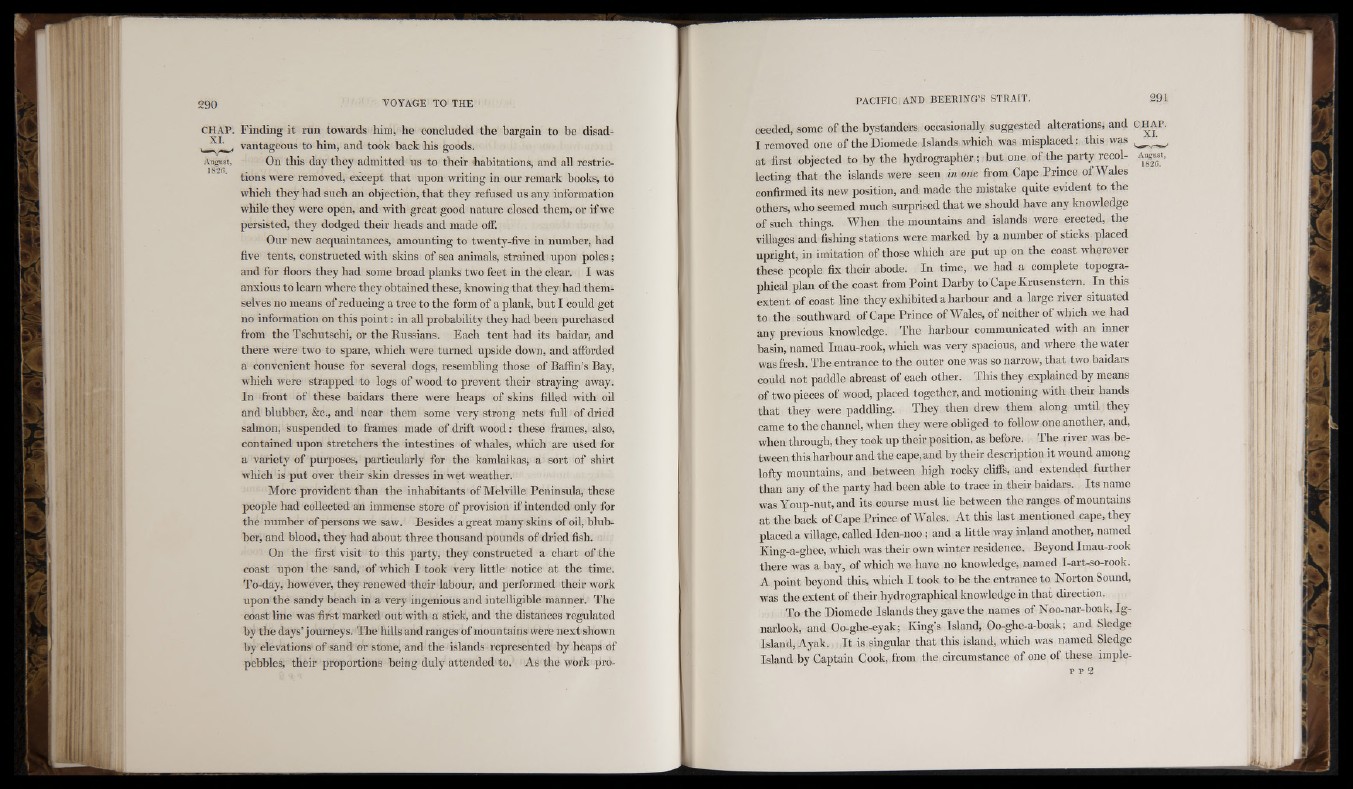
CHAP.
XI.
Ausiiist,
Finding it run towards him, he concluded the bargain to be disadvantageous
to him, and took back his goods.
On tliis day they admitted us to their habitations, and all restrictions
were removed, except that upon writing in our remark books, to
which they had such an objection, that they refused us any information
while they were open, and with great good nature closed them, or if we
persisted, they dodged their heads and made off.
Our new acquaintances, amounting to twenty-five in number, had
five tents, constructed with skins of sea animals, strained upon poles;
and for floors they had some broad planks two feet in the clear. I was
anxious to learn where they obtained these, knowing that they had themselves
no means of reducing a tree to the form of a plank, but I could get
no information on this point; in all probability they had been purchased
from the Tschutschi, or the Russians. Each tent had its baidar, and
there were two to spare, which were turned upside down, and afforded
a convenient house for several dogs, resembling those of Baffin’s Bay,
which were strapped to logs of wood to prevent their straying away.
In front of these baidars there were heaps of skins filled with oil
and blubber, &c., and near them some very strong nets fuU of dried
salmon, suspended to frames made of drift wood: these frames, also,
contained upon stretchers the intestines of whales, which are used for
a variety of purposes, particularly for the kamlaikas, a sort of shirt
which is put over their skin dresses in w'et weather.
More provident than the inhabitants of Melville Peninsula, these
people had collected an immense store of provision if intended only for
the number of persons we saw. Besides a great many skins of oil, blubber,
and blood, they had about three thousand pounds of dried fish.
On the first visit to this party, they constructed a chart of the
coast upon the sand, of which I took very little notice at the time.
To-day, however, they renewed their labour, and performed their work
upon the sandy beach in a very ingenious and intelligible manner. The
coast line was first marked out with a stick, and the distances regulated
by the days’journeys. The hills and ranges of mountains were next shown
by elevations of sand or stone, and the islands represented by heaps of
pebbles, their proportions being duly attended to. As the work pro-
ceeded, some of the bystanders occasionally suggested alterations, and CHAP
I removed one of the Diomede Islands which was misplaced; this was ^ _
at first objected to by the hydrographer; but one of the party recollecting
August,
182G.
that the islands were seen in one from Cape Prince of Wales
confirmed its new position, and made the mistake quite evident to the
others, who seemed much surprised that we should have any knowledge
of such things. YVhen the mountains and islands were erected, the
viUages and fishing stations were marked by a number of sticks placed
upright, in imitation of those which are put up on the coast wherever
these people fix their abode. In time, we had a complete topographical
plan of the coast from Point Darby to Cape Krusenstern. In this
extent of coast line they exhibited a harbour and a large river situated
to the southward of Cape Prince of YY"ales, of neither of which we had
any previous knowledge. The harbour communicated with an inner
basin, named Imau-rook, which was very spacious, and where the water
was fresh. The entrance to the outer one was so narrow, that two baidars
could not paddle abreast of each other. This they explained by means
of two pieces of wood, placed together, and motioning with their hands
that they were paddling. They then drew them along untd they
came to the channel, when they were obliged to follow one another, and,
when through, they took up their position, as before. The river was between
this harbour and the cape, and by their description it wound among
lofty mountains, and between high rocky cliffs, and extended further
than any of the party had been able to trace in their baidars. Its name
was Youp-nut, and its course must he between the ranges of mountains
at the back of Cape Prince of YY'ales. At this last mentioned cape, they
placed a village, called Iden-noo ; and a little way inland another, named
Kiiig-a-ghee, which was their own winter residence. Beyond Imau-rook
there was a bay, of which we have no knowledge, named I-art-so-rook.
A point beyond this, wliich I took to be the entrance to Norton Sound,
was the extent of their hydrographic.il knowledge in that direction.
To the Diomede Islands they gave the names of Noo-nar-boak, Ig-
iiarlook, and Oo-ghe-eyak; King’s Island, Oo-ghe-a-boak; and Sledge
Island, Ayak. It is singular that this island, which was named Sledge
Island by Captain Cook, from the circumstance of one of these impler
r 2